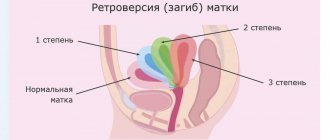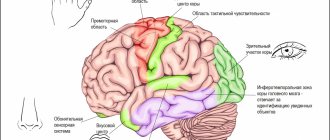Heavy periods - menstrual flow in quantities greater than the individual or general norm; usually come with lumps (clots). This is a common problem that occurs in approximately 30% or more of girls and women.
- How to determine?
- Signs
- Causes of heavy periods
- Heavy menstruation in teenagers
- Heavy periods in premenopause
- Heavy periods after childbirth
- Heavy periods after abortion
- Heavy menstruation due to medication
- Treatment
What are clots? This is excess menstrual blood that did not have time to be released from the uterus and began to clot. If you have such a problem, you need to determine its causes as early as possible.
How to determine?
Criteria for assessing critical days (monthly):
- duration (normal: no more than 1 week)
- profuseness (the largest amount of blood is released in the first 2-3 days, then only “residues” are released)
- volume of blood loss (in 24 hours the maximum should be 150 ml, and the average amount: 120 ml)
- duration of the intermenstrual period (minimum 21 days)
- presence of painful sensations (pain can be moderate, or even slight discomfort is present, no more)
- bleeding between critical days (this should not happen in healthy females)
Based on the criteria listed above, you can understand for yourself whether you have normal or heavy periods. Abundance is a syndrome whose causes are varied. This may be gynecological or other pathology. That is why it is important to contact a qualified doctor to prescribe tests to discover the true cause. Then it will be possible to decide what to do.
List of sources
- Podzolkova N.M. Symptom, syndrome, diagnosis. Differential diagnosis in gynecology. Podzolkova N.M., Glazkova O.L. 3rd ed., rev. and additional M.: GEOTAR-Media, 2014;
- Vikhlyaeva, E.M. Guide to endocrine gynecology /ed. EAT. Vikhlyaeva.- M.: Med. information Agency, 2002;
- Gynecology: a textbook for students of medical universities. Kulakov V.I., Serov V.N. Gasparov A.S. – M.: Medical Information Agency LLC. – 2005;
- Smetnik V.P., Tumilovich L.G. “Non-operative gynecology: A guide for doctors”, M.: “Medical Information Agency”, 2000.
Signs
Heavy periods are also called menorrhagia or hyperpolymenorrhea. They are characterized by the following manifestations:
- duration of menstruation 8 days or more
- significant blood discharge, quite large clots present
- per day you lose 150 ml of blood or even more
- you have to change pads and tampons very often, approximately every 60 minutes, even at night
- the menstrual cycle lasts less than 21 days
- blood begins to be released even in the middle of the cycle
- menstrual days are accompanied by significant, sometimes unbearable pain
- bleeding is abundant throughout the entire period of menstruation (and not in the first couple of days)
- bleeding or menstruation occurs 12 months or later after the onset of menopause
When to see a doctor?
If large clots appear during menstruation, you should consult a gynecologist, especially if the discharge is heavy, prolonged and accompanied by pain.
You should not worry if your periods come regularly and there is no or moderate pain.
It is necessary to go to the gynecologist about clots during menstruation in the following situations:
- Menstruation lasts more than a week, the discharge is heavy.
- Pregnancy is planned and attempts are made to conceive. In this case, the discharge may indicate that the egg has been rejected and a miscarriage has occurred.
- Discharge during menstruation contains large clots with an unpleasant odor.
- A woman experiences severe pain during her period. This may be a sign of inflammation or hormonal disorders.
Causes of heavy periods
The reason may lie in the woman’s general health, in her emotional stress, in hereditary factors or in the state of the reproductive system. The most common reasons:
- hyperplastic processes of the endometrium (most often endometrial hyperplasia or polyps)
- adenomyosis
- cancer
- uterine fibroids
- hormonal imbalances in women at the age of menopause or in girls during puberty
- uterine inflammation or inflammatory process in the appendages
- wearing an intrauterine device
- taking anticoagulants and antiplatelet agents
- blood diseases
- genetic factors
- lack of minerals and vitamins, without which normal blood clotting is impossible
- abortion
- childbirth, especially with complications
- ectopic pregnancy
- changes in climate conditions
- excessive fatigue and constant stress
- thyroid diseases
- pathologies of the urinary, cardiovascular or liver systems
- excessive physical activity
- the predominance of fermented milk products in the diet (mainly in women who are on specific diets)
- abuse of emergency hormonal contraception (use several times a month, etc.)
- improper use of hormonal drugs
Content
- Causes of heavy blood loss during menstruation
- Heavy menstruation in teenagers
- Hemostatic drugs for menstruation
Every woman's body is individual. This is especially true for the reproductive system. Each woman's menstrual cycle has individual characteristics. And very often the fair sex faces such a problem as heavy periods. And this applies not only to pain, but also to heavy bleeding. What to do in such a situation? What to drink during menstruation, when the amount of blood loss is significant? This question worries many women. In this article you will find answers to the question of what could be the cause of heavy menstruation and what hemostatic drugs can be used during menstruation.
Heavy menstruation in teenagers
In adolescents, this problem occurs in 37 cases out of 100. This mainly happens in the first 3 years after menarche (first menstruation). Possible reasons:
- improper diet (fasting, mono-diets, chaotic meals, which leads to a lack of certain substances in the body)
- infectious diseases (acute and chronic)
- mental overload
- mental trauma
- constant stress (including from an unhealthy family environment), which affects the functioning of the pituitary gland and hypothalamus
The above factors affect the monotonous production of estrogen, as well as the lack of progesterone in the body. The result is processes of hyperplasia in the uterus without the stage of secretory transformation (as should be normal). Stagnation of blood and expansion of capillaries causes heavy periods. The uneven rejection of the endometrium and the death of some of its zones also play a role. Hypoplasia of the uterus and a decrease in its contractility also contribute to the abundance of menstruation.
In adolescents (puberty), menstruation can vary in duration and intensity. The consequences may be:
- decrease in prothrombin index
- low platelet count
- increase in heart rate (heart rate)
- pallor of mucous membranes and skin
- loss of appetite
- fast fatiguability
- feeling of weakness
NMC classification
Violations are classified:
- By duration.
- Cyclicality.
- The amount of blood released.
- Impact on well-being.
The following disorders are distinguished by cyclicity:
- Opsomenorea – infrequent periods, the menstrual cycle is longer than 35 days.
- Proyomenorrhea – frequent periods, menstrual cycle less than 21 days.
- Spaniomenorea – very rare menstruation, no more than 4 times a year.
- Amenorrhea is the complete absence of menstruation for six months or more.
According to duration, failures are divided into 2 types:
- Oligomenorrhea – periods are too short, less than 2 days.
- Polymenorrhea is an excessively long menstruation, from 8 to 12 days.
Based on the amount of blood released, there are:
- Hypomenorrhea – very scanty periods.
- Hypermenorrhea – heavy menstrual bleeding.
Based on their effect on well-being, NMCs were previously divided into several types:
- Algomenorrhea – deterioration of the general condition (nausea, headache, vomiting, etc.).
- Dysmenorrhea – pain in the lower abdomen without deterioration in overall health.
- Algodismenorrhea – pain in the lower abdomen combined with poor condition.
Nowadays, all of the above disorders are called dysmenorrhea. There is also a condition known as PMS - premenstrual syndrome. It is expressed by irritability, mood swings, depression, anxiety, swelling, headaches, and discomfort in the mammary glands.
Reference! PMS occurs in 20-25% of women. In 5% it is severe.
Hemorrhagic metropathy is also a menstrual disorder. This is abnormal uterine bleeding that is not caused by the usual causes for abnormal uterine bleeding (gynecological diseases, systemic pathologies, pregnancy or its complications, hormonal disorders, medications, etc.). It occurs due to the fact that in the second phase of the menstrual cycle the follicle does not transform into the corpus luteum. Then it reverses or degenerates into a cyst. Without progesterone, which the corpus luteum is supposed to produce, the old endometrium remains in place and becomes filled with blood. Later, it is still rejected, but not completely. In the absence of the corpus luteum, excess estrogen secretion occurs, under the influence of which the endometrium grows. Due to malnutrition, degenerative processes occur in it with tissue death, accompanied by bleeding. Most often, abnormal uterine bleeding develops in adolescents (20%) of cases and in women over 45 years of age (50% of cases).
Heavy periods in premenopause
The age of premenopause begins at the age of 45 and ends at approximately 55. The likelihood of conceiving a child at this age becomes less and less as the end of menstruation approaches. After a year has passed since your last period without bleeding, this period of time is called “menopause”.
The stage that comes after is called postmenopause. Sex hormones are produced to a minimum. And then bleeding from the uterus is considered a disease. The ovaries, pituitary gland and hypothalamus age during this period, and therefore do not function as before. The cyclic production of gonadotropins, the maturation of follicles and the production of sex hormones are disrupted. The consequence is relative hyperestrogenemia and absolute hyperprogesteronemia. This is followed by hyperplasia of the uterine mucosa.
During the premenopausal period, menstruation becomes heavier and lasts longer than at the age of 30 or 35 years. Acyclic bleeding (blood flow from the uterus in the middle of the cycle) is also possible at this age. Tumor-like formations and tumors can form that change the muscular uterine layer into endometriotic or connective tissue. The consequence is a loss of uterine contractility, which leads to heavy periods or bleeding after stress, excessive physical activity or sexual intercourse.
What is considered a menstrual disorder?
- Delay of menstruation by more than 10 days.
- Shortening the cycle by 5-7 days.
- Increase or decrease in the volume of menstrual flow.
- Accompanying menstruation with deterioration of well-being and/or severe pain.
- Discharge of blood outside of menstruation (minor bleeding during ovulation is part of the norm).
- Complete cessation of menstruation before menopause.
- Uterine bleeding during menopause.
Reference! In order for a change in a cycle to be called a violation, it must be repeated over several cycles. Situational, that is, single changes (increasing or shortening the cycle by 5-7 days) are not violations and are considered a type of norm.
Heavy periods after childbirth
After the birth of a child, periods become longer and more intense. The reason is the anatomical changes in the cervix and the uterus itself. The cervical canal becomes wider and shorter. The uterus also becomes larger, that is, during menstruation, more blood is released due to an increase in the area of the mucous membrane.
But sometimes menorrhagia after childbirth, including after cesarean section, is a pathology. The reasons mainly lie in overstretching of the uterus or abnormalities in labor. These reasons lead to disruption of the organ's ability to contract as usual.
The occurrence of heavy periods after childbirth is also influenced by the course of pregnancy. The following factors are at play:
- pregnancy complications
- pregnancy stress
- low hemoglobin level
- malnutrition
If a caesarean section was performed for some reason, the suture remaining on the uterus disrupts its contractility to a certain extent. The scar, as you know, consists of connective tissue.
Blood clots during menstruation are normal
This phenomenon during menstruation does not always indicate the presence of pathology. It is quite possible that your periods are normal and there is no need to worry. As you know, these days the endometrium dies and is removed, which becomes loose and thick during the cycle. That is, the menstrual discharge itself is not liquid, since it consists not only of blood, but also of the tissues of the inner lining of the uterus and glandular secretions. In addition, their consistency and color change every day.
Usually, during menstruation, blood clots come out as soon as a woman gets out of bed after sleeping or from a chair after sitting for a long time. This is explained by the fact that the blood in the uterus, when lying down or sitting, stagnates and begins to coagulate, forming clots. As soon as the woman gets up, they come out, and this is not a deviation from the norm.
To make menstrual flow easier, special anticoagulant enzymes inhibit blood clotting. If the bleeding is heavy, the enzymes cannot cope with their task and some of the blood clots in the vagina. That's why it comes out in clumps.
Heavy periods after abortion
During pregnancy, hormone levels change in a woman's body. Therefore, the body finds itself under stress conditions if the pregnancy is terminated for some reason. This affects the balance of hormones. Blood appears after intrauterine interventions (curettage or hysteroscopy). But this is not considered menstruation.
After intrauterine interventions, menstruation begins approximately 30 days later. Blood from the genital tract after curettage of the uterus will flow from 3 to 7 days, the maximum is 10 days. The discharge of most girls/women after operations inside the uterus is scanty and there is no pain. If, after an abortion or intrauterine interventions, you experience heavy bleeding, you urgently need to run to the doctor.
The reason may be hidden in inflammatory intrauterine processes. If this is the case, your period will resemble meat slop or be dark red. Pain in the lower abdomen may be cramping in nature. Body temperature may rise. Manifestations of intoxication of the body, including dyspeptic symptoms, may also be present.
If the diagnosis of endometritis is not confirmed, malfunctions in the ovarian-pituitary-hypothalamus system are suspected. The doctor prescribes combined oral contraceptives. The treatment period ranges from 3 to 6 months.
What happens during menstruation?
Every month, regardless of a woman’s wishes, her uterus prepares to receive a fertilized egg. Under the influence of hormones, the inner layer of the uterus, the endometrium, begins to thicken. If pregnancy does not occur, the level of hormones decreases, the blood supply to the mucous membrane of the inner surface of the uterus stops, the endometrium is rejected and excreted through the genital tract. Thus, menstrual discharge is a complex mixture consisting of blood, mucus, endometrial particles, and vaginal cells.
Heavy menstruation due to medication
Heavy periods occur due to treatment with certain medications.
- antiplatelet agents and anticoagulants
The cause may be taking these drugs because they make the blood thinner. Anticoagulants include, first of all, phenylin, heparin and syncumar. Antiplatelet agents: chimes, trental, aspirin, etc. If you are being treated with these drugs and suffer from heavy periods, ask your doctor to reduce the dosage or stop the drug.
- hormonal medications
Heavy periods can be caused by taking combined oral contraceptives. This may happen if you violated the dosage regimen, or if the drug was chosen incorrectly by the doctor. Do not use hormonal medications on your own; they must be prescribed by a doctor. The dosage may also differ from the one that was prescribed to your friend, or that you found on the Internet.
Taking hormonal drugs after unprotected sexual intercourse (emergency contraception) can cause menorrhagia. These drugs act due to a huge dose of hormones, so doctors do not advise abusing them. Sometimes special treatment is needed to restore a normal cycle.
Treatment with duphaston can also lead to lengthening of critical days and their abundance. In some cases, bleeding also continues after the cessation of menstruation. The reason is completely typical - a change in hormonal balance. Menstruation will become normal after 2 or 3 months.









